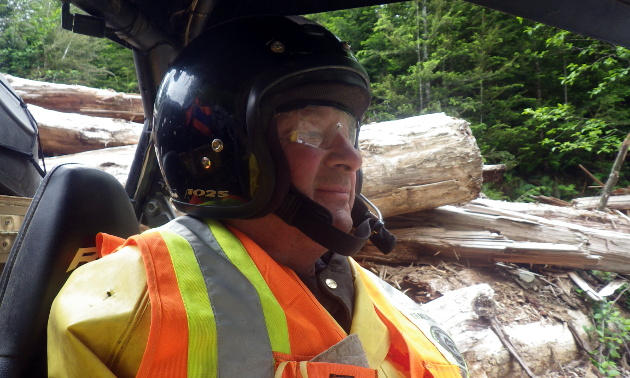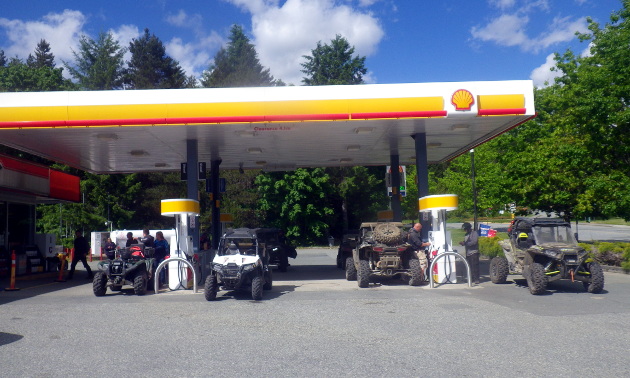Legal access to trail systems has always been a balancing act. Upon the delivery and inception of the new ORV Act in B.C. in 2014, some grey areas have prompted the Quad Riders Association of British Columbia (ATVBC) to work with provincial lawmakers to figure out solutions to recurring access problems.
With the revisions presented in the new ORV Act, the issue of crossing roads legally has been mostly addressed, with some fine tuning in the works. OHV riders can now legally cross public roadways, provided registration and insurance requirements have been addressed. This is great, but what if there could be more?
Mike Coulter of Campbell River, B.C., had a vision that would affect motorized recreation in British Columbia. As the past president of the Campbell River ATV Club and the North Island representative for ATVBC, Coulter is beyond passionate about ORV tourism in British Columbia.
Initially, his focus was on North Island tourism, but as word of his efforts spread, many communities throughout B.C. have expressed interest in ORV tourism and what it could mean for the province. Linking B.C. towns together by designated ORV trails could mean a huge economic boost for many areas.
“When you embark on a 1,000-kilometre loop in the North Island, you will visit at least eight separate communities,” said Coulter. “There are basic needs such as food, fuel and lodging in addition to other consumer spending. This is huge for many rural towns that need economic stimulus.”

Mike Coulter is a passionate rider from Campbell River, B.C. — photo courtesy Mike Coulter
Success stories
The idea of ORV tourism isn’t a new concept as there are many successful initiatives in existence, such as the Hatfield-McCoy Trail in West Virginia. On that trail system, only nine per cent of the riders are from West Virginia, with the remaining 91 per cent being tourists from Canada and the United States. The tourist attraction grosses over $9 million per year that is directly associated with this initiative.
In 2000, the town of Gilbert, West Virginia, had 16 motel rooms, one gas station and one restaurant. By 2008, after the development of the Hatfield-McCoy trail system, there were 130 motel rooms, multiple restaurants, a cinema, a grocery store, a large RV park and two auto repair shops.
“ORV tourism is huge,” said Coulter. “Why are we sending people to places such as Mexico, Utah, Oregon, California and Alberta when we have everything we need right here to create the same experience with just a bit of adjustment needed to the existing ORV Act?”
Unlimited potential
Tourism potential doesn’t simply end with a guided trail ride. Tourism operations, such as zip line adventures, fishing, hiking, hot springs, wine tours, whale watching and local attractions will all see an influx of visitors. This is huge for B.C., which has so much to offer. With our dollar being desirable to visitors from the U.S., British Columbia will be the logical choice for family vacations.
“Many families enjoy getting out on their ATVs and side-by-sides for vacations,” said Coulter. “Ask a child from an outdoorsy family what they’d choose, Disneyland or an adventure on their ATV? The ATV will win hands down! We just need to create access to our existing trail systems, streamline the permitting process and increase signage for designated ORV routes.”
As it exists right now, a specific Operation Permit, MV1815, can be issued for those wanting to traverse public roadways to link to existing trails. Many of the trails in B.C. don’t line up according to the requirements needed in the ORV Act even if there were simply a few metres of variance, it would be considered an illegal crossing and a permit would be needed.
“Some may think, ‘Well, I can just scoot across, no one will notice,’ but if an incident should occur, it is imperative that riders are aware that they must operate within the scope of the law or liability insurance coverage will be null and void,” said Kim Smith, who is the land and environment co-ordinator/general manager of ATVBC.
The permits are free, and last up to two years and are issued by the local RCMP detachment. This seems like an easy fix for those non-conforming crossings, but the challenges with such a system are many:
- ORV users must request a permit at the local RCMP detachment closest to the roadway crossing. If you plan a long trip that traverses terrain in a multitude of RCMP detachment areas, a permit must be issued by each detachment prior to embarking on the adventure.
- Each permit is filled out manually, taking roughly 20 minutes to complete. This is time-consuming and a drain on rural communities’ law enforcement, which often have small detachments that simply don’t have the time to fill out such paperwork, especially if a group ride is planned with over a dozen riders.
- With the requirement to obtain a permit prior to the adventure from each RCMP detachment, this process is difficult for out-of-town riders and it could realistically take days to drive the route in a vehicle to fill out the paperwork before the ORV adventure can begin.
- Municipal governments have absolutely no weight in granting permit access. The permitting process is strictly at the discretion of the local RCMP detachment. It has been noted that some commanding officers may have a negative perception of ORV use and therefore refuse permits based upon their personal opinion, affecting not only rider access but economic influx.
Setting a new stereotype
Who is the rider of today? If you search mainstream media articles relating to ORV use, you’ll probably see a picture or two of helmetless riders ripping up the land and disrupting spawning channels of freshwater streams, with an obnoxious aftermarket exhaust proudly displayed. No wonder some people may feel a little hesitant about supporting more access for ATVs and side-by-sides.
Is this really what ORV riders are like?
“The majority of ORV riders in British Columbia are over the age of 50 and want to get out into the backcountry and continue to enjoy life,” said Coulter. “We see many riders who’ve lost mobility due to age, illness or injury who need to be able to enjoy nature, as they’ve always done.”
Hardworking organizations such as ATVBC are creating a new image for ORV riders in B.C., including retired riders, families and individuals who simply want to get out into nature respectfully and legally.
What do we need to move forward?
B.C. already has the infrastructure in place, with numerous logging and forest service roads acting as safe trail systems into the backcountry. Very little is needed from an infrastructure perspective except signage. The process needs to be more user-friendly and allow for municipal levels of government to have more discretion as far as permit processing.

Thanks to the efforts of the Campbell River ATV Club, riders with an operation permit have access, via designated routes, to food, fuel and accommodation in the community of Woss, which is on North Vancouver Island. — photo courtesy Mike Coulter
“We need to streamline the process to make it easier and more cost-effective,” said Coulter. “Rather than leaving the RCMP with the burden of time-consuming paperwork, we’d love for local municipalities to have more influence on the permitting and legislation, allowing ORV access to food, fuel and lodging on specific designated routes.”
Rather than permits issued from separate law enforcement detachments, it is a suggestion of ATVBC to designate trail systems and require one permit for each designated trail to better facilitate tourism and the permitting process.
The dream many have for riding on public roadways and utilizing ORVs as grocery getters is a long way off, mainly due to the astronomical cost of insurance. However, access to food, lodging and fuel on designated routes is a goal that is obtainable and already happening in communities such as those on the North Island and Elkford. Efforts of ATVBC and Mike Coulter are creating even more opportunities for ORV use and tourism in B.C. The 2018 Annual ATVBC Spring F2F Conference is focused on the theme “Developing, Promoting and Growing Responsible ORV Tourism in BC.”
Support your local ATVBC club to facilitate initiatives such as these. More information can be found on the ATVBC website.








Comments